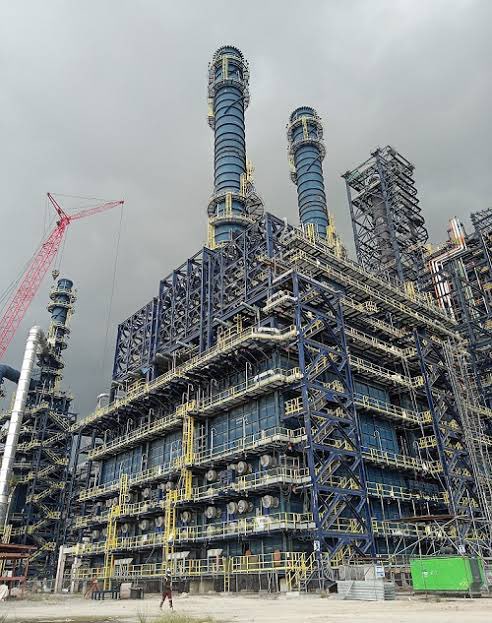Dangote Refinery shocks the market by importing crude oil from Ghana for the first time as operations climb to 70% capacity amid regional competition.
In a move that has caught the attention of energy watchers across Africa, the Dangote Petroleum Refinery has imported crude oil from Ghana for the first time. This new development is not just a milestone for the $20 billion refinery, but also a signal that Dangote is actively diversifying its crude supply sources to maintain steady operations.
The news comes at a time when there have been growing concerns over whether the refinery — Africa’s largest — can meet its ambitious targets and live up to expectations. By branching out to Ghana, Dangote appears to be sending a message of resilience and adaptability.
ALSO READ: Abia Government Suspends Ariaria International Market Chairman, Appoints Acting Replacement
Operations Rising, But Not Yet at Full Strength
According to figures released by energy intelligence firm Kpler, the refinery is currently running at about 450,000 barrels per day (kbd). This represents nearly 70% of its total capacity and an improvement from the 400,000 barrels per day recorded during the first quarter of 2025.
While this increase is notable, it still falls short of the 650,000-barrel-per-day nameplate capacity, which was one of the major selling points of the refinery when it was inaugurated. For now, Dangote seems focused on strengthening its supply base and gradually pushing output higher rather than rushing to maximum capacity.

Why Ghana’s Crude Oil Is a Big Deal
The refinery recently began refining Sankofa crude oil, a medium-sweet crude produced offshore Ghana. Sankofa has an API gravity of 29 and a relatively low sulfur content of 0.3%, making it suitable for refining into high-quality petroleum products.
In August, Dangote broadened its sourcing mix with a variety of imports, including:
Five Suezmax tankers carrying Nigerian crude,
Two Very Large Crude Carriers (VLCCs) from the United States,
And one shipment of Sankofa crude from Ghana.
This combination highlights a deliberate effort to build a more diverse and reliable portfolio of crude sources, which is essential for consistent operations.
Diversifying Beyond Nigeria and the U.S.
For much of its early operations, Dangote Refinery relied heavily on Nigerian crude, alongside imports of light sweet crude from the United States. However, market analysts have long argued that overdependence on a limited number of supply sources could leave the refinery vulnerable to disruptions.
In addition to bringing in Ghana’s Sankofa, Kpler reported that Brass River crude has also returned to Dangote’s production list after being absent for nearly a year. This reintroduction is another clear sign that the refinery is prioritizing flexibility and diversity.
By broadening its supply channels, Dangote reduces the risk of interruptions and improves its chances of keeping up with rising fuel demands in Nigeria and across Africa.
A New Challenger: Cameroon’s Refinery Comeback
While Dangote is busy expanding its reach, competition is also looming on the horizon. In a related development, Cameroon’s national oil company, Sonara, has revealed plans to restart its Limbe Refinery by 2027.
The Limbe facility has been inactive for eight years following a devastating fire. If it successfully comes back online, it could reintroduce significant competition into the West and Central African refining market. For Dangote, which is currently seen as a game-changer in the region, this would mean adapting to a more competitive environment.
What This Means for the African Energy Market
Dangote’s decision to import crude from Ghana carries wider implications beyond its refinery walls. It shows how regional cooperation in oil and gas could help strengthen Africa’s self-sufficiency in energy. Instead of relying heavily on imports from outside the continent, countries are beginning to explore ways to trade and refine resources closer to home.
For Nigeria, Ghana, and the rest of West Africa, such collaboration could mean more reliable fuel supply, reduced costs, and potentially lower fuel prices in the long run. It could also support job creation and economic growth across the energy value chain.
The Road Ahead
Despite skepticism about whether the Dangote Refinery can meet its full production goals, recent moves suggest steady progress. By importing Sankofa crude from Ghana, reintroducing Brass River crude, and keeping up a mix of Nigerian and American supplies, the refinery is showing signs of building a stronger foundation.
As operations climb toward full capacity, Dangote’s strategy appears focused on stability first, expansion next. And with competition on the horizon from Cameroon and possibly other refiners in the region, the coming years will be crucial in shaping the refinery’s dominance.
For now, the refinery’s bold step of sourcing from Ghana has added a new twist to the story — one that keeps the energy sector, investors, and the public watching closely.
FAQs About Dangote’s Crude Import
- What is Sankofa crude oil?
Sankofa is a medium-sweet crude oil produced offshore Ghana. It has an API gravity of 29 and low sulfur content, making it efficient for refining into quality fuels. - Why is Dangote Refinery importing crude from Ghana?
The refinery is diversifying its supply sources to ensure reliability and reduce dependence on Nigerian and U.S. crude oil. - How much crude oil can Dangote Refinery process daily?
The refinery has a nameplate capacity of 650,000 barrels per day, making it the largest in Africa. Currently, it is operating at about 70% of that capacity. - Will the import of Ghana’s oil affect fuel prices in Nigeria?
In the long term, greater supply stability and regional cooperation could help stabilize or lower prices, though immediate effects may vary depending on market conditions. - Who could become Dangote’s biggest competitor in the region?
Cameroon’s Limbe Refinery, expected to resume operations by 2027, may emerge as a strong competitor in the West and Central African oil market.












